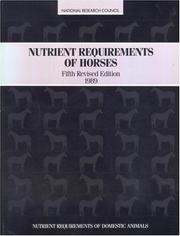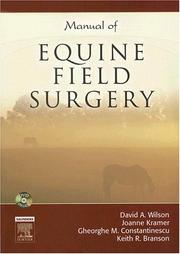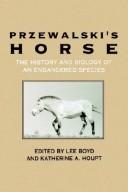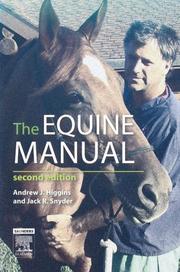| Listing 1 - 10 of 21 | << page >> |
Sort by
|
Article
Year: 2003
Abstract | Keywords | Export | Availability | Bookmark
 Loading...
Loading...Choose an application
- Reference Manager
- EndNote
- RefWorks (Direct export to RefWorks)
Camel. --- Equus przewalskii. --- Equus-przewalskii. --- General biology. --- Geographical distribution. --- Przewalski.
Article
Year: 1988
Abstract | Keywords | Export | Availability | Bookmark
 Loading...
Loading...Choose an application
- Reference Manager
- EndNote
- RefWorks (Direct export to RefWorks)
Equus przewalskii. --- Equus-przewalskii. --- Herd. --- Horse. --- Interaction. --- Interactions. --- Primitive horse. --- Przewalski horse. --- Przewalski. --- Social interaction. --- Social interactions. --- Social-interaction. --- Social. --- Zoo.
Article
Abstract | Keywords | Export | Availability | Bookmark
 Loading...
Loading...Choose an application
- Reference Manager
- EndNote
- RefWorks (Direct export to RefWorks)
The aim of this study was to investigate social behaviour in differently reared stallions in their respective environments; one group of stallions was reared under typical domestic conditions whereas the other group was reared and lives under natural conditions. The domestic group consisted of 19, 2-year-old stallions (Equus caballus), which were all weaned at 4 months of age and experienced either individual or group housing facilities before being pastured with the other similarly aged stallions. The natural living and mixed age group of Przewalski stallions (E. przewalskii) consisted of 13 stallions, most of which were juveniles (n=11, 4 years; n=2, >9 years). The domestic group was studied in a 4-ha enclosure at the Danish Institute of Agricultural Sciences and the Przewalski group under free-ranging conditions in a 75-ha enclosure in the Askania Nova Biosphere Reserve, Ukraine. Behavioural data was collected during 168 h of direct observation. The occurrence of 14 types of social interactions was recorded and group spacing behaviour was studied using nearest neighbour recordings. In spite of very different environments, reflecting domestic and natural rearing conditions, many similarities in behaviour was found. Play and play fight behaviour was very similar in the two stallion groups. Quantitative differences were found in social grooming since Przewalski stallions groomed more frequently (P=0.004), and in investigative behaviours, since domestic stallions showed more nasal (P=0.005) and body sniffing (P<0.001), whereas Przewalski stallions directed more sniffing towards the genital region (P<0.001). These differences may, however, be attributed to environmental factors and in the period of time the stallions were together prior to the study period. Quantitative differences appeared in some agonistic behaviours (kick threat, P<0.001; and kick, P<0.001), but data do not support earlier findings of Przewalski horses being significantly more aggressive than do
Age. --- Aggressive. --- Agonistic behaviour. --- Agonistic. --- Behaviour. --- Distance. --- Domestic horse. --- Environment. --- Environments. --- Equus caballus. --- Equus przewalskii. --- Equus-caballus. --- Equus-przewalskii. --- Fight. --- Grooming. --- Group housing. --- Group. --- Horse. --- Horses. --- Housing. --- Interaction. --- Interactions. --- Kept. --- Natural. --- Observation. --- Pasture. --- Play. --- Przewalski horse. --- Przewalski. --- Rearing. --- Sniffing. --- Social behaviour. --- Social grooming. --- Social interaction. --- Social interactions. --- Social-interaction. --- Social. --- Spacing behaviour. --- Stallion group. --- Stallion. --- Time.
Multi
ISBN: 9090031103 Year: 1989 Publisher: Utrecht Universiteit Utrecht
Abstract | Keywords | Export | Availability | Bookmark
 Loading...
Loading...Choose an application
- Reference Manager
- EndNote
- RefWorks (Direct export to RefWorks)
Biological techniques --- Animal physiology. Animal biophysics --- Mammals --- Horses. --- Locomotion. --- Locomotions --- Equus caballus --- Equus przewalskii --- Horse, Domestic --- Domestic Horse --- Domestic Horses --- Horse --- Horses, Domestic --- Theses --- Horses --- Locomotion --- Locomotor Activity --- Activities, Locomotor --- Activity, Locomotor --- Locomotor Activities
Book
ISBN: 9062553583 Year: 1988 Publisher: Zutphen Terra
Abstract | Keywords | Export | Availability | Bookmark
 Loading...
Loading...Choose an application
- Reference Manager
- EndNote
- RefWorks (Direct export to RefWorks)
Animal husbandry --- Horses. --- Animal Husbandry. --- #ABIB:aimm --- 636.1 --- 636.084/.087 --- $?$88/12 --- Animal Husbandries --- Husbandries, Animal --- Husbandry, Animal --- Equus caballus --- Equus przewalskii --- Horse, Domestic --- Domestic Horse --- Domestic Horses --- Horse --- Horses, Domestic --- Horses --- Animal husbandry. --- Animal Husbandry
Book
ISBN: 0716704919 Year: 1977 Publisher: San Francisco, Calif. Freeman
Abstract | Keywords | Export | Availability | Bookmark
 Loading...
Loading...Choose an application
- Reference Manager
- EndNote
- RefWorks (Direct export to RefWorks)
Animal husbandry --- Mammals --- Cheval --- horses --- History --- Race (animal) --- Breeds (animals) --- Sélection --- Selection --- Alimentation des animaux --- Animal feeding --- Reproduction --- reproduction --- Méthode d'amélioration génétique --- breeding methods --- Anatomie animale --- animal morphology --- Maladie des animaux --- Animal diseases --- Parasite --- Parasites --- Logement des animaux --- Animal housing --- Gestion de l'exploitation agricole --- Farm management --- Horses. --- Horses --- 636.1 --- Equus caballus --- Farriery --- Hippology --- Horse --- Domestic animals --- Equus --- Livestock --- Pachyderms --- Hinnies --- Mules --- Equus przewalskii --- Horse, Domestic --- Domestic Horse --- Domestic Horses --- Horses, Domestic --- Selection. --- reproduction.

ISBN: 0309039894 Year: 1989 Publisher: Washington (D.C.) : National academy of sciences,
Abstract | Keywords | Export | Availability | Bookmark
 Loading...
Loading...Choose an application
- Reference Manager
- EndNote
- RefWorks (Direct export to RefWorks)
Horses. --- Nutritional Requirements. --- Horses --- -Horses --- -636.1 --- 636.084.4 --- $?$90/04 --- Equus caballus --- Farriery --- Hippology --- Horse --- Domestic animals --- Equus --- Livestock --- Pachyderms --- Hinnies --- Mules --- Dietary Requirements --- Nutrition Requirements --- Dietary Requirement --- Nutrition Requirement --- Nutritional Requirement --- Requirement, Dietary --- Requirement, Nutrition --- Requirement, Nutritional --- Requirements, Dietary --- Requirements, Nutrition --- Requirements, Nutritional --- Food --- Equus przewalskii --- Horse, Domestic --- Domestic Horse --- Domestic Horses --- Horses, Domestic --- Feeding and feeds --- Nutrition --- -Requirements --- Feeding and feeds. --- Requirements. --- Nutritional Requirements --- 636.1 --- Nutrition&delete& --- Requirements --- Animal Nutritional Physiological Phenomena. --- Animal Nutritional Physiological Phenomena

ISBN: 1416002707 9781416002703 9781437710380 1437710387 Year: 2006 Publisher: [Place of publication not identified] Saunders Elsevier
Abstract | Keywords | Export | Availability | Bookmark
 Loading...
Loading...Choose an application
- Reference Manager
- EndNote
- RefWorks (Direct export to RefWorks)
HORSES. --- Horses --- Veterinary surgery --- Veterinary surgery. --- Diseases --- Treatment --- Surgery --- Equidae --- Perissodactyla --- Mammals --- Vertebrates --- Chordata --- Animals --- Eukaryota --- Organisms --- Health & Biological Sciences --- Veterinary Medicine --- Equus caballus --- Equus przewalskii --- Horse, Domestic --- Domestic Horse --- Domestic Horses --- Horse --- Horses, Domestic --- Eucarya --- Eukarya --- Eukaryotes --- Eukaryotas --- Eukaryote --- Animalia --- Animal --- Metazoa --- Chordates --- Chordate --- Vertebrate --- Mammalia --- Mammal --- Perissodactylas --- Ass --- Equus asinus --- Asses --- Donkeys --- Mules --- Zebras --- Donkey --- Mule --- Zebra --- Farriery --- Veterinary medicine --- Hippology --- Domestic animals --- Equus --- Livestock --- Pachyderms --- Hinnies --- surgery

ISBN: 0585044902 9780585044903 0791418898 0791418901 0791497313 Year: 1994 Publisher: Albany : State University of New York Press,
Abstract | Keywords | Export | Availability | Bookmark
 Loading...
Loading...Choose an application
- Reference Manager
- EndNote
- RefWorks (Direct export to RefWorks)
Przewalski's horse. --- Horses. --- Przewalski's horse --- Agriculture --- Earth & Environmental Sciences --- Animal Sciences --- Equus caballus --- Equus przewalskii --- Horse, Domestic --- Domestic Horse --- Domestic Horses --- Horse --- Horses, Domestic --- Asian wild horse --- Asiatic wild horse --- Horse, Przewalski's --- Mongolian tarpan --- Mongolian wild horse --- Prejevalsky's horse --- Prjevalsky's horse --- Przevalsky horse --- Przewalski horse --- Przhevalski's horse --- Taki --- Tarpan, Mongolian --- Wild horse, Asian --- Wild horse, Asiatic --- Wild horse, Mongolian --- Equus

ISBN: 9780702037214 0702037214 9780702027697 Year: 2006 Publisher: [Place of publication not identified] Elsevier Saunders
Abstract | Keywords | Export | Availability | Bookmark
 Loading...
Loading...Choose an application
- Reference Manager
- EndNote
- RefWorks (Direct export to RefWorks)
Animal psychology and neurophysiology --- Mammals --- Veterinary pathology --- Animal Diseases --- Equidae --- Diseases --- Perissodactyla --- Vertebrates --- Chordata --- Animals --- Eukaryota --- Organisms --- Horses --- Horse Diseases --- Health & Biological Sciences --- Veterinary Medicine --- Equine Diseases --- Disease, Equine --- Disease, Horse --- Diseases, Equine --- Diseases, Horse --- Equine Disease --- Horse Disease --- Equus caballus --- Equus przewalskii --- Horse, Domestic --- Domestic Horse --- Domestic Horses --- Horse --- Horses, Domestic --- Eucarya --- Eukarya --- Eukaryotes --- Eukaryotas --- Eukaryote --- Animalia --- Animal --- Metazoa --- Chordates --- Chordate --- Vertebrate --- Mammalia --- Mammal --- Perissodactylas --- Ass --- Equus asinus --- Asses --- Donkeys --- Mules --- Zebras --- Donkey --- Mule --- Zebra --- Diseases, Animal --- Disease --- veterinary
| Listing 1 - 10 of 21 | << page >> |
Sort by
|

 Search
Search Feedback
Feedback About
About Help
Help News
News